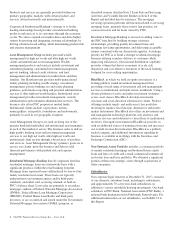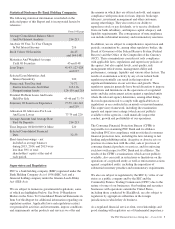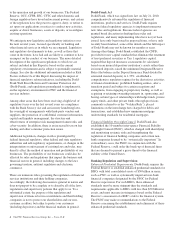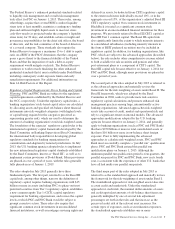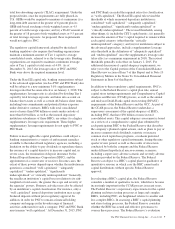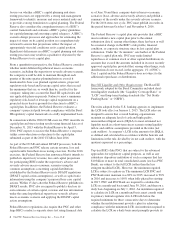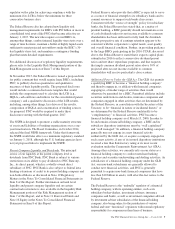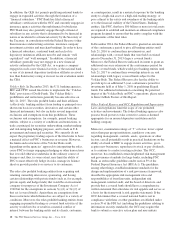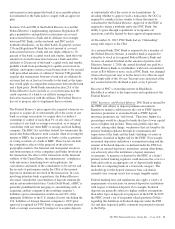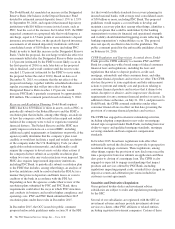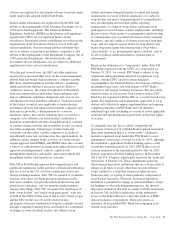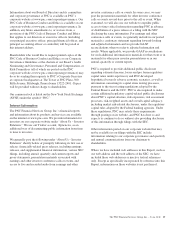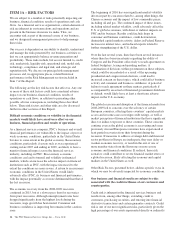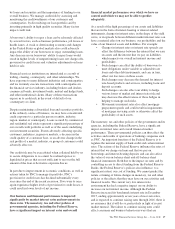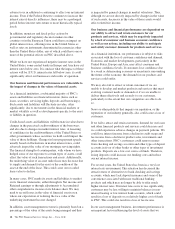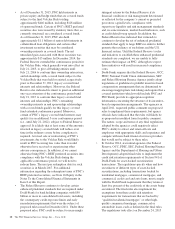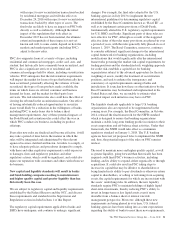PNC Bank 2015 Annual Report Download - page 29
Download and view the complete annual report
Please find page 29 of the 2015 PNC Bank annual report below. You can navigate through the pages in the report by either clicking on the pages listed below, or by using the keyword search tool below to find specific information within the annual report.
enforcement action against the bank if an acceptable plan is
not submitted or the bank fails to comply with an approved
plan.
Sections 23A and 23B of the Federal Reserve Act and the
Federal Reserve’s implementing regulation, Regulation W,
place quantitative and qualitative restrictions on covered
transactions between a bank and its affiliates (for example
between PNC Bank, on the one hand, and PNC and its
nonbank subsidiaries, on the other hand). In general, section
23A and Regulation W limit the total amount of covered
transactions between a bank and any single affiliate to 10
percent of the bank’s capital stock and surplus, limit the total
amount of covered transactions between a bank and all its
affiliates to 20 percent of the bank’s capital stock and surplus,
prohibit a bank from purchasing low-quality assets from an
affiliate, and require certain covered transactions to be secured
with prescribed amounts of collateral. Section 23B generally
requires that transactions between a bank and its affiliates be
on terms that are at least as favorable to the bank as the terms
that would apply in comparable transactions between the bank
and a third party. Dodd-Frank amended section 23A of the
Federal Reserve Act to include as a covered transaction the
credit exposure of a bank to an affiliate arising from a
derivative transaction with the affiliate. The Federal Reserve
has yet to propose rules to implement these revisions.
The Federal Reserve’s prior approval is required whenever we
propose to acquire all or substantially all of the assets of any
bank or savings association, to acquire direct or indirect
ownership or control of more than 5% of any class of voting
securities of any bank or savings association, or to merge or
consolidate with any other BHC or savings and loan holding
company. The BHC Act and other federal law enumerates the
factors the Federal Reserve must consider when reviewing the
merger of BHCs, the acquisition of banks, or the acquisition
of voting securities of a bank or BHC. These factors include
the competitive effects of the proposal in the relevant
geographic markets; the financial and managerial resources
and future prospects of the companies and banks involved in
the transaction; the effect of the transaction on the financial
stability of the United States; the organizations’ compliance
with anti-money laundering laws and regulations; the
convenience and needs of the communities to be served; and
the records of performance under the CRA of the insured
depository institutions involved in the transaction. In cases
involving interstate bank acquisitions, the Federal Reserve
also must consider the concentration of deposits nationwide
and in certain individual states. Under Dodd-Frank, a BHC is
generally prohibited from merging or consolidating with, or
acquiring, another company if the resulting company’s
liabilities upon consummation would exceed 10% of the
aggregate liabilities of the U.S. financial sector (including the
U.S. liabilities of foreign financial companies). OCC prior
approval is required for PNC Bank to acquire another insured
bank or savings association by merger or to acquire deposits
or substantially all of the assets of such institutions. In
deciding whether to approve such a transaction, the OCC is
required to consider factors similar to those that must be
considered by the Federal Reserve. Approval of the FDIC is
required to merge a nonbank entity into PNC Bank. Our
ability to grow through acquisitions or reorganize our
operations could be limited by these approval requirements.
At December 31, 2015, PNC Bank had an “Outstanding”
rating with respect to the CRA.
As a national bank, PNC Bank is required to be a member of
the Federal Reserve System. A member bank is required to
subscribe to stock in its regional Federal Reserve Bank and
receives an annual dividend on the amount of paid-in stock.
Effective January 1, 2016, the annual dividend rate paid by a
Federal Reserve Bank to stockholders with total consolidated
assets of $10 billion or more, such as PNC Bank, was changed
(from a flat 6 percent rate) to be the lower of (i) the rate equal
to the high yield of the 10-year Treasury note auctioned at the
last auction before the dividend is paid, or (ii) 6 percent.
Because of PNC’s ownership interest in BlackRock,
BlackRock is subject to the supervision and regulation of the
Federal Reserve.
FDIC Insurance and Related Matters. PNC Bank is insured by
the FDIC and subject to deposit premium assessments.
Regulatory matters could increase the cost of FDIC deposit
insurance premiums to an insured bank as FDIC deposit
insurance premiums are “risk based.” Therefore, higher fee
percentages would be charged to banks that have lower capital
ratios or higher risk profiles. These risk profiles take into
account, among other things, weaknesses that are found by the
primary banking regulator through its examination and
supervision of the bank and the bank’s holdings of assets or
liabilities classified as higher risk by the FDIC. For example,
an insured depository institution’s examination rating and the
amount of brokered deposits (as defined under the FDI Act)
held by an insured depository institution, among other things,
can adversely affect the institution’s deposit insurance
assessments. A negative evaluation by the FDIC or a bank’s
primary federal banking regulator could increase the costs to a
bank and result in an aggregate cost of deposit funds higher
than that of competing banks in a lower risk category. The
methodology for the deposit insurance base calculation
currently uses average assets less average tangible equity.
Federal banking laws and regulations also apply a variety of
requirements or restrictions on insured depository institutions
with respect to brokered deposits. For example, brokered
deposits are generally subject to higher outflow assumptions
than other types of deposits for purposes of the LCR. In 2015,
the FDIC issued a set of frequently asked questions (FAQs)
regarding the definition of brokered deposits under the FDI
Act and then requested public comment on potential revisions
to the FAQs.
The PNC Financial Services Group, Inc. – Form 10-K 11



